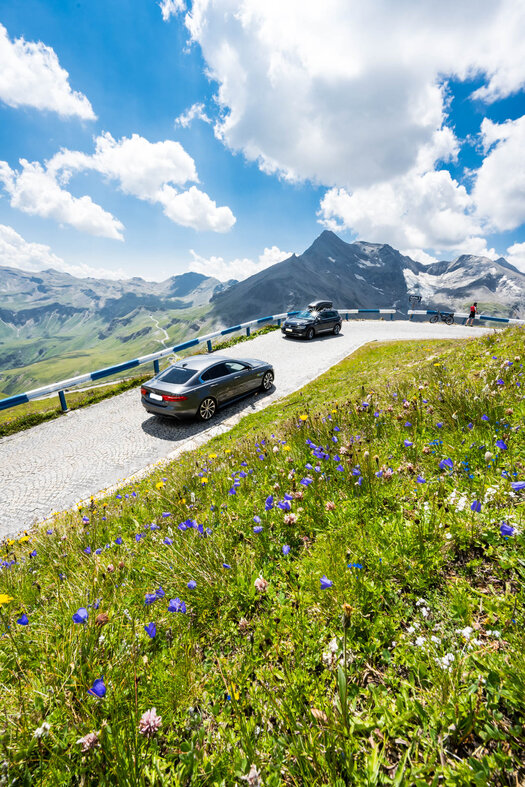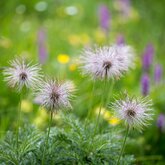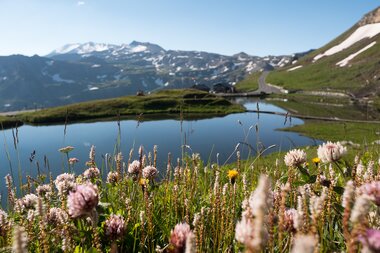Experience the colourful Alpine meadows! The steep pastures along the Grossglockner High Alpine Road – the heart of the Hohe Tauern National Park – are among the most species-rich flower-filled pastures in the Alps! The colourful array of flowers attracts butterflies, wild bees, bumblebees, grasshoppers and many other insects. These magnificent looking meadows are delicate eco systems that are sensitive to the slightest change.
A colourful, blossoming variety
What fantastic shapes and colours! What an aroma! And how things buzz and drone, creep and fly! This is what it like to look at the many, dreamily beautiful flower-filled meadows which flourish in all their glory along the Grossglockner High Alpine Road. What can be seen there? Sunshine yellow mountain herb bennet, bright blue stemless enzian, delicate purple bellflowers, snow-white Alpine marguerites, green-yellow lady’s mantel, dark red nigretella, the pale-yellow elder-flowered orchid, soft white alpine leek and the light purple martagon lily. To name but a few examples of the floral varieties that grow here. Quite different of course due to the altitude, location and the soil composition. Yet all these blossoming beauties have one thing in common – they all compete for the attention of butterflies, bees, bumble bees, locusts and beetles whose habitat is right in the middle of this vibrant array of flowers, herbs and grasses.

Collect moments. Not things.
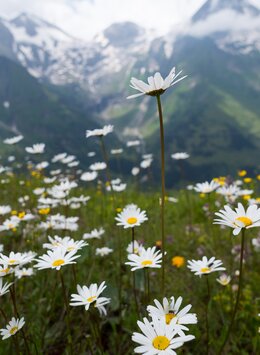
In Consideration of nature
Do not walk on the flower-filled meadows
We realise how tempting it is to lie in the middle of a blossoming meadow. To have a picnic. Or snap photos for the family album, Instagram & the like. But imagine if all our visitors did that, each and every day … That’s why we ask you to keep to the paths and not pick the flowers. The plants and animals in the Hohe Tauern National Park are conservation protected. And by the way, you can get brilliant photos of the lovely flowers, butterflies and the like, even from the paths!
Blossoming mountain oases: sensitive eco systems that are worth protecting
The mountain pastures in the Hohe Tauern National Park are among the most species-rich habitats in the Alps! However, behind this seemingly carefree variety there is a clever eco system. Species that want to survive here successfully have to be well adapted and cope with a very short vegetation period, extreme cold in the winter, considerable fluctuations in temperature in the summer, strong wind and intense sunshine. A change in just one of these factors change will affect this delicate habitat. It is all the more important then to understand each individual building block of the complex relationships and dependencies of this ecosystem in order to provide it with protection in the future.
Wonderful Pockhorner Wiesen: An abundance of plants and variety of insects
Driving on the Grossglockner High Alpine Road to Kaiser-Franz-Josefs-Höhe, between Gasthaus Schöneck and the Glocknerhaus, you pass a special floral gem, at which you definitely ought to plan an interim stop-off in summer especially. After all, it is here, directly above the Grossglockner High Alpine Road between 2000 and 2200 metres altitude that you will come across the ‘Pockhorner Wiesen’. These flower-filled mountain pastures are home to some 140 different types of plants on an area spanning just 100 m². Flowers and insects live here in a many-faceted symbiosis; a fascinating realm!
- Our tip: in the summer months, definitely plan to make a stop-off on the ‘Wunderwelt Glocknerwiesen’ circular route, behind Gasthaus Schöneck. After all, you won’t just learn lots of interesting information about this sensitive eco system here, there is a great deal of discover about the beautiful flowers too. The flowers that are already in bloom have been given plates. And quite by the by, the splendid colours of this blossoming meadow are staggeringly beautiful!
The martagon lily (Lilium martagon) – a fragrant beauty
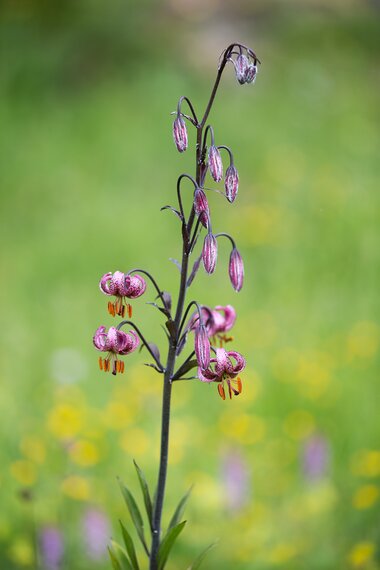
The elegant martagon lily, also known as ‘Turk’s Cap Lily’, grows up to one metre in height in Pockhorner Wiesen. It takes its name from its recurved petals, which look like a turban. This striking light purple-red flower also has a lengthy, protruding style and six long stamens with large, brown-red anthers. Hence this lovely flower is a genuine rarity – and one of only three types of lily to grow wild in the region. And the martagon lily is a real ‘night owl’, or to put it another way, it comes into its own at night-time. After all, as the day comes to a close in the Hohe Tauern National Park, the petals nod gently in the wind, exuding a heady, sweet scent which entices butterflies with long proboscises, for instance the night hawk moth.
The elderberry orchid (Dactylorhiza sambucina) – a clever deceiver

One particularly cunning plant that is an excellent example of the highly specialised interplay between plants and animals, is the elderberry orchid. This nectarless orchid uses a very special trick to be pollinated even without providing sweet insect food. The elderberry orchid impersonates the nectar-rich leafy lousewort which is in blossom at this time. Pollinators, for the most part wild bees and bumble bees, mistake the flowers up until the point they learn to tell the difference between the two. Until then they also pollinate the elderberry orchid – wholly without the reward of sweet nectar – which can then continue to reproduce … very clever indeed!
A piece of flower happiness
A piece of the flowering meadowland joy of the Grossglockner High Alpine Road can be found in the Glockner Shops, including the Glockner mountain and meadow herb tea – a floral mix of elderberry, peppermint, melissa, cornflower, marigold, raspberry, blackberry and strawberry leaves


